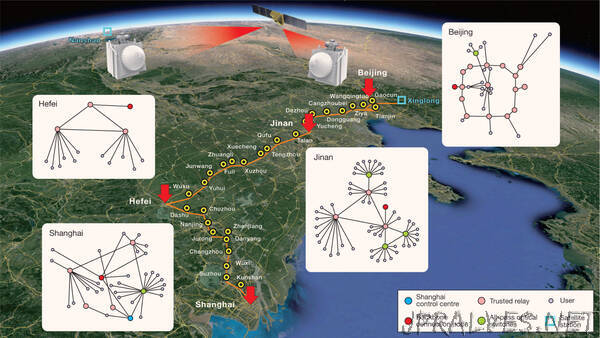
“A team of researchers in China has demonstrated an integrated space-to-ground quantum communication network that combines a large-scale fiber network of more than 700 fiber links and two high-speed satellite-to-ground free-space links.
“Quantum key distribution (QKD) uses the quantum states of particles to form a string of zeros and ones, while any eavesdropping between the sender and the receiver will change this string or key and be noticed immediately,” said Professor Jianwei Pan from the University of Science and Technology of China and colleagues.
“QKD has the potential to enable secure communication and information transfer.”
“In the laboratory, the feasibility of point-to-point QKD is evident from the early proof-of-concept demonstration in the laboratory over 32 cm. This distance was later extended to the 100-km scale with decoy-state QKD and more recently to the 500-km scale with measurement-device-independent QKD.”
“Several small-scale QKD networks were also tested outside the laboratory. However, a global QKD network requires a practically — not just theoretically — secure and reliable QKD network that can be used by a large number of users distributed over a wide area.”
In 2016, China launched the world’s first quantum communication satellite — the Quantum Experiments at Space Scale (QUESS), or Mozi/Micius — and achieved QKD with two ground stations which are 2,600 km apart.
A year later, an over 2,000-km-long optical fiber network was completed for QKD between Beijing and Shanghai.
Using trusted relays, the ground-based fiber network and the satellite-to-ground links were integrated to serve more than 150 industrial users across China, including state and local banks, municipal power grids, and e-government websites.
“Our work shows that quantum communication technology is sufficiently mature for large-scale practical applications,” Professor Pan said.
“Similarly, a global quantum communication network can be established if national quantum networks from different countries are combined, and if universities, institutions and companies come together to standardize related protocols, hardware, etc.”
Professor Pan and co-authors tested and improved the performance of different parts of the integrated network.
For instance, with an increased clock rate and more efficient QKD protocol, the satellite-to-ground QKD now has an average key generation rate of 47.8 kilobits per second, which is 40 times higher than the previous rate.
“We plan to further expand the network in China and to develop small-scale, cost-efficient QKD satellites and ground-based receivers, as well as medium and high earth orbit satellites to achieve all-time, ten-thousand-km-level QKD,” the researchers said.
Their paper was published this week in the journal Nature.
Y.A. Chen et al. An integrated space-to-ground quantum communication network over 4,600 kilometres. Nature, published online January 6, 2021; doi: 10.1038/s41586-020-03093-8”
